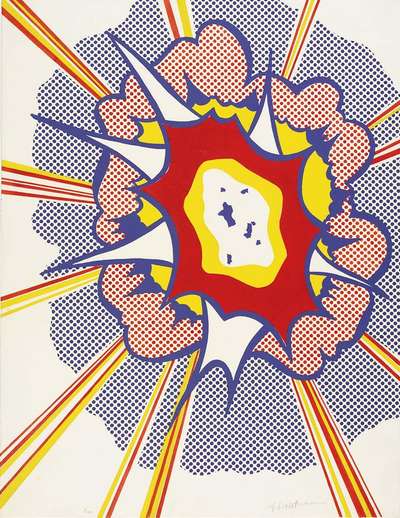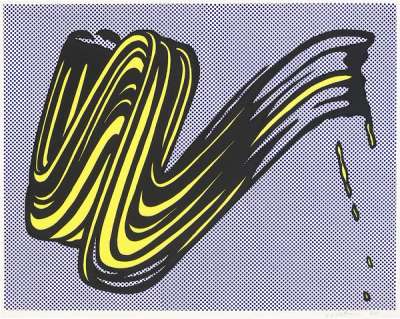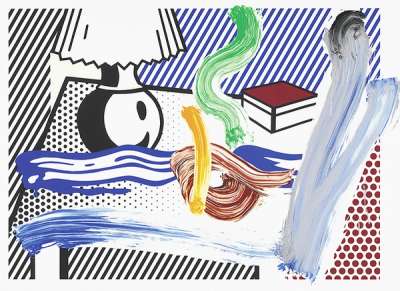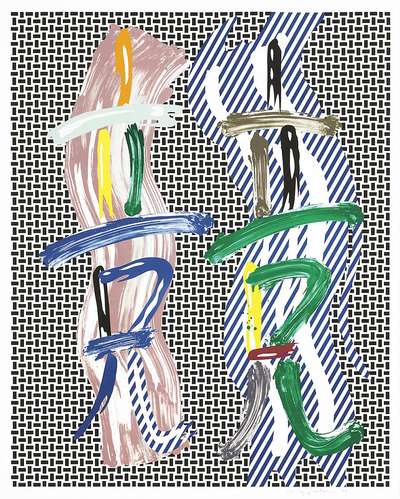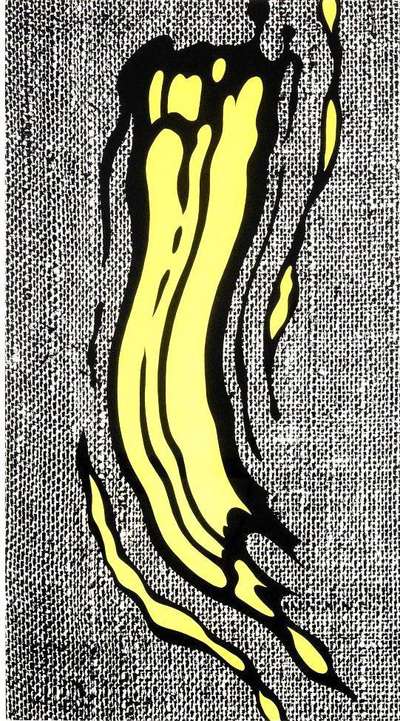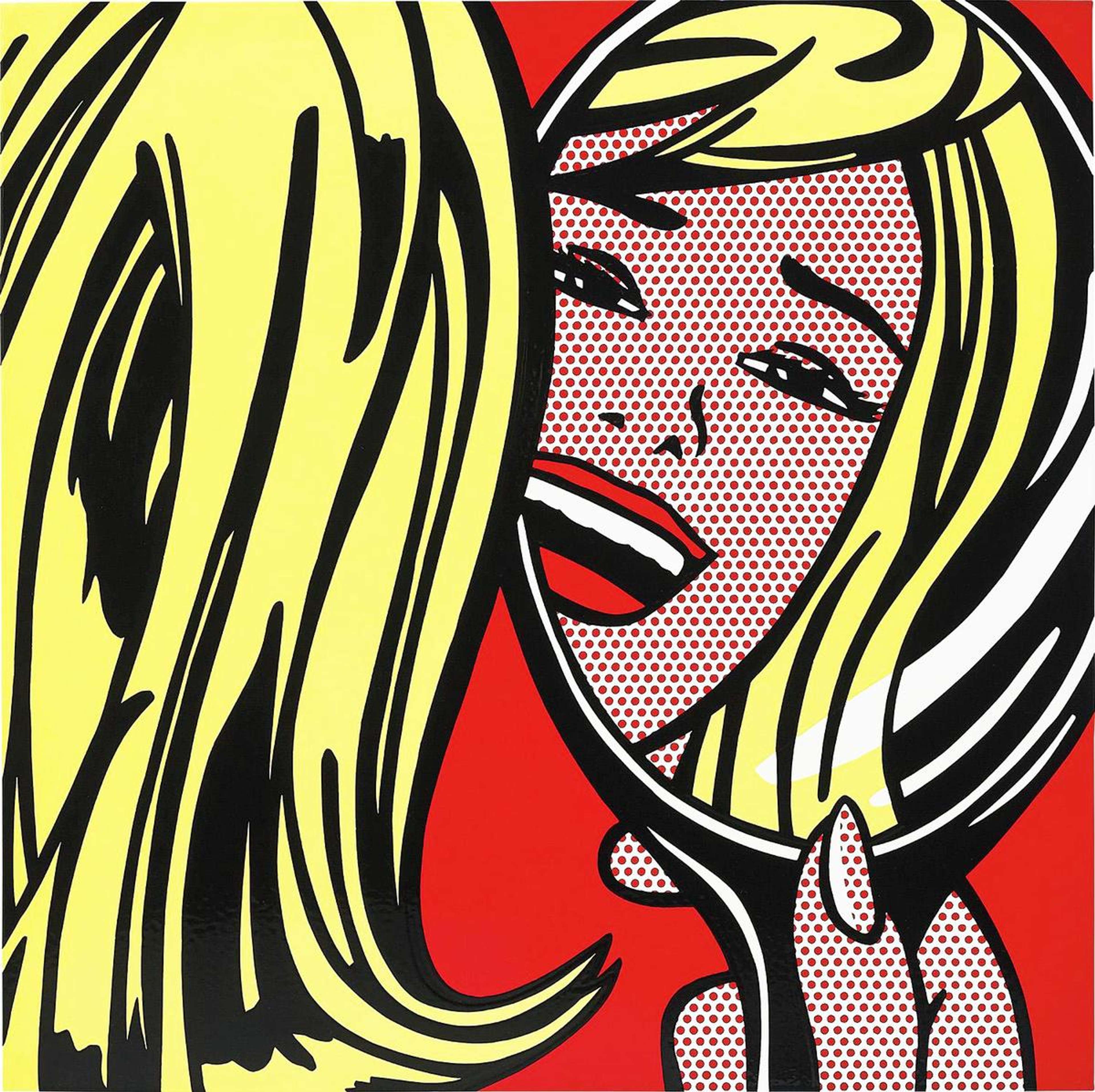 Brushstroke © Roy Lichtenstein 1965
Brushstroke © Roy Lichtenstein 1965Roy Lichtenstein, a prominent figure in the Pop Art movement, revolutionised the art world with his iconic works that merged popular culture, advertising, and fine art. One of Lichtenstein's most significant series, Brushstrokes, challenged traditional notions of artistic representation and aimed to deconstruct and recontextualise the fundamental elements of painting—the brushstroke. The series, created by Lichtenstein in the 1960s, painstakingly replicated the gestural marks associated with Abstract Expressionism. Using his signature Ben-Day dots and bold lines, Lichtenstein transformed the act of painting into a graphic language that celebrated mass media and consumer culture.
The Story Behind Roy Lichtenstein's Brushstrokes Series
Roy Lichtenstein's Brushstrokes series emerged as a transformative body of work, challenging conventional notions of art and representation. Inspired by the Abstract Expressionist movement, Lichtenstein sought to deconstruct and reinterpret the gestural brushstrokes that had long been celebrated as the epitome of artistic expression.
The series began in the mid-1960s as Lichtenstein experimented with capturing the essence of brushstrokes through his distinctive comic book-inspired style. By meticulously reproducing the bold, black outlines and vibrant colours of brushstrokes, he created a sense of visual irony and self-reflection. The works simultaneously celebrated and parodied the traditional notion of the artist's hand, blurring the boundaries between high and low art.
The Brushstrokes series also served as Lichtenstein's commentary on the commodification of art and the impact of mass media on artistic production. By appropriating the visual language of commercial printing and comic book imagery, he not only referenced popular culture but also subverted the notion of originality and the aura of the unique art object.
The Technique of Roy Lichtenstein's Brushstrokes
In this iconic series, rather than using traditional brushstrokes, Lichtenstein recreated the look of brushwork through imitation, as the series showcases the artist's ability to mimic and reinterpret the visual language of popular culture. Lichtenstein's technique drew inspiration from the world of commercial printing and advertising -- by appropriating the aesthetics of mass-produced images, he infused his works with a bold, graphic quality reminiscent of comic book panels and signage. Through careful observation and meticulous execution, Lichtenstein captured the precision and crispness of printed advertisements.
Central to Lichtenstein's artistic vocabulary was his fascination with comic book art. He absorbed the visual language of this popular medium, incorporating its dynamic lines, vibrant colours, and stylised depictions into his work. The Brushstrokes series showcases Lichtenstein's deliberate playfulness with the notion of the "artist's hand," as he replicated the gestural strokes of a painter's brush with the precision of a mechanical reproduction. By appropriating the techniques of commercial art and elevating them within the realm of fine art, Lichtenstein challenged established hierarchies in the art world.
Through this innovative approach, the Brushstrokes series epitomises the fusion of high and popular culture within the Pop Art movement. Lichtenstein's technique not only paid homage to the aesthetics of commercial imagery but also questioned notions of originality and authenticity in art.
Exploring Roy Lichtenstein's Brushstrokes and Explosions Series
Lichtenstein's Brushstrokes and Explosions series represent pivotal moments in the artist's career and the larger context of Pop Art. While both series showcase Lichtenstein's signature bold and graphic style, they explore different subject matters and offer distinct insights into the artist's creative process.
The Brushstrokes series, created in the mid-1960s, is a meta-commentary on the act of painting itself. Lichtenstein's fascination with the mechanical reproduction of images is evident. In contrast, the Explosions series, which emerged in the late 1960s, captures the dynamic and explosive nature of comic book explosions. Lichtenstein employs bold colours, thick outlines, and dramatic compositions to recreate these moments of action and impact. The series reflects Lichtenstein's continued exploration of popular culture imagery, as well as his fascination with the visual language of comics and the intersection of art and mass media.
While the Brushstrokes series focuses on the process and perception of art-making, the Explosions series delves into the realm of popular culture and its visual narratives. Both series exemplify Lichtenstein's meticulous technique and his ability to transform mundane, everyday imagery into iconic and impactful works of art.
In the context of Pop Art history, the Brushstrokes and Explosions series embody Lichtenstein's engagement with the cultural landscape of the time. These series epitomise his ability to distil and reimagine imagery from the mass media, infusing it with his distinctive style and elevating it to the realm of fine art.
 Red And White Brushstrokes © Roy Lichtenstein 1965
Red And White Brushstrokes © Roy Lichtenstein 1965Roy Lichtenstein's Red and White Brushstrokes: A Masterpiece of Pop Art
At the forefront of Roy Lichtenstein's transformative Brushstrokes series, the iconic painting Red And White Brushstrokes stands as a powerful embodiment of the Pop Art movement. Through its striking composition, bold colour scheme, and thought-provoking execution, this artwork continues to captivate viewers.
The painting showcases Lichtenstein's masterful manipulation of familiar comic book imagery. The composition is deceptively simple, consisting of a dynamic arrangement of thick, painterly brushstrokes in vivid red and white against a background textured with blue Ben-Day dots. The deliberate choice of these contrasting colours creates a visual impact that is hard to ignore, immediately drawing the viewer's attention to the energetic brushwork.
By appropriating the aesthetics of mass-produced comic book panels, Lichtenstein challenges the boundaries between high and low culture, redefining the concept of art itself. Through his meticulous hand-painted technique, he transforms the mechanical dots and lines of printed images into vibrant, expressive brushstrokes, blurring the line between fine art and popular culture.
Red And White Brushstrokes holds significant historical and artistic significance within the Pop Art movement and in wider contemporary art. It fetched 28.3 million at Christie’s New York in May 2017, becoming one of his most valuable works.
The Legacy of Roy Lichtenstein's Brushstrokes Series
The influence of Lichtenstein's Brushstrokes can be seen in the works of countless contemporary artists who continue to draw inspiration from his distinctive style. Its bold visual language and subversion of traditional artistic techniques have inspired artists like Jeff Koons and Yayoi Kusama to experiment with colour, composition, and the appropriation of popular imagery. Lichtenstein's innovative approach paved the way for subsequent generations to challenge artistic conventions and explore the intersection of fine art and popular culture.
The series sparked a broader dialogue on the role of appropriation and the power of popular culture in art, setting the stage for the emergence of movements such as Neo-Pop and Postmodernism. Artists today incorporate elements of Lichtenstein's bold lines, vibrant colours, and graphic compositions to comment on consumer culture, mass media, and the pervasive influence of technology.
The continued relevance and significance of Pop Art, of which Lichtenstein was a leading figure, cannot be overstated. The movement challenged the traditional hierarchy of art, democratising the medium by incorporating elements of popular culture and mass production. Lichtenstein's Brushstrokes series exemplifies this ethos, inviting viewers to question the nature of art and its relationship to everyday life.






